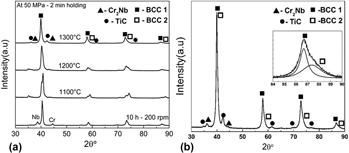Crossref Citations
This article has been cited by the following publications. This list is generated based on data provided by
Crossref.
Osipov, Denis A.
Smirnov, Ivan V.
Grinyaev, Konstantin V.
and
Ditenberg, Ivan A.
2020.
Microstructure and microhardness of Ni3Al after spark plasma sintering and subsequent heat treatments.
Vol. 2310,
Issue. ,
p.
020232.
Raman, Lavanya
Karthick, G.
Guruvidyathri, K.
Fabijanic, Daniel
Narayana Murty, S. V. S.
Murty, B. S.
and
Kottada, Ravi S.
2020.
Influence of processing route on the alloying behavior, microstructural evolution and thermal stability of CrMoNbTiW refractory high-entropy alloy.
Journal of Materials Research,
Vol. 35,
Issue. 12,
p.
1556.
Lv, Shasha
Zu, Yufei
Chen, Guoqing
Zhao, Bojun
Fu, Xuesong
and
Zhou, Wenlong
2020.
A multiple nonmetallic atoms co-doped CrMoNbWTi refractory high-entropy alloy with ultra-high strength and hardness.
Materials Science and Engineering: A,
Vol. 795,
Issue. ,
p.
140035.
Chawake, Niraj
Zálešák, Jakub
Gammer, Christoph
Franz, Robert
Cordill, Megan J.
Kim, Jeong Tae
and
Eckert, Jürgen
2020.
Microstructural characterization of medium entropy alloy thin films.
Scripta Materialia,
Vol. 177,
Issue. ,
p.
22.
Ditenberg, I. A.
Smirnov, I. V.
Osipov, D. A.
Grinyaev, K. V.
and
Korchagin, M. A.
2020.
Influence of Mechanical Activation Duration on the Microhardness of a Multicomponent W–Ta–Mo–Nb–Zr–Cr–Ti System.
Russian Physics Journal,
Vol. 63,
Issue. 6,
p.
1096.
Petroglou, Dimitris
Poulia, Anthoula
Mathiou, Christina
Georgatis, Emmanuel
and
Karantzalis, Alexander E.
2020.
A further examination of MoTaxNbVTi (x = 0.25, 0.50, 0.75 and 1.00 at.%) high-entropy alloy system: microstructure, mechanical behavior and surface degradation phenomena.
Applied Physics A,
Vol. 126,
Issue. 5,
Ditenberg, Ivan A.
Smirnov, Ivan V.
Grinyaev, Konstantin V.
Osipov, Denis A.
Gavrilov, Alexander I.
and
Korchagin, Michail A.
2020.
Morphology, structural-phase state and microhardness of a multicomponent non-equiatomic W-Ta-Mo-Nb-Zr-Cr-Ti powders mixture depending on the duration of ball milling.
Advanced Powder Technology,
Vol. 31,
Issue. 10,
p.
4401.
Han, Jiesheng
Su, Bo
Lu, Jinjun
Meng, Junhu
Zhang, Aijun
and
Wu, Youzhi
2020.
Preparation of MoNbTaW refractory high entropy alloy powders by pressureless spark plasma sintering: Crystal structure and phase evolution.
Intermetallics,
Vol. 123,
Issue. ,
p.
106832.
Ditenberg, Ivan A.
Smirnov, Ivan V.
Korchagin, Michail A.
Grinyaev, Konstantin V.
Melnikov, Vladlen V.
Pinzhin, Yuriy P.
Gavrilov, Alexander I.
Esikov, Maksim A.
Mali, Vyacheslav I.
and
Dudina, Dina V.
2020.
Structure and Phase Composition of a W-Ta-Mo-Nb-V-Cr-Zr-Ti Alloy Obtained by Ball Milling and Spark Plasma Sintering.
Entropy,
Vol. 22,
Issue. 2,
p.
143.
Chen, Chun-Liang
and
Sutrisna
2021.
Influence of V and Heat Treatment on Characteristics of WMoNbTaV Refractory High-Entropy Alloy Coatings by Mechanical Alloying.
Coatings,
Vol. 11,
Issue. 3,
p.
265.
Kalali, Deekshith G.
Antharam, Sairam
Hasan, Mohsin
Karthik, P. Sai
Phani, P. Sudharshan
Bhanu Sankara Rao, K.
and
Rajulapati, Koteswararao V.
2021.
On the origins of ultra-high hardness and strain gradient plasticity in multi-phase nanocrystalline MoNbTaTiW based refractory high-entropy alloy.
Materials Science and Engineering: A,
Vol. 812,
Issue. ,
p.
141098.
Raman, Lavanya
Anupam, Ameey
Karthick, G.
Berndt, Christopher C.
Ang, Andrew Siao Ming
Narayana Murty, S V S
Fabijanic, Daniel
Murty, B S
and
Kottada, Ravi Sankar
2021.
Strengthening mechanisms in CrMoNbTiW refractory high entropy alloy.
Materials Science and Engineering: A,
Vol. 819,
Issue. ,
p.
141503.
Ditenberg, I. A.
Smirnov, I. V.
Osipov, D. A.
and
Korchagin, M. A.
2021.
Structural-Phase State and Microhardness of a Precursor from Equiatomic W-Ta-Mo-Nb-Zr-Cr-Ti Powder Mixture after High-Energy Mechanical Activation.
Physical Mesomechanics,
Vol. 24,
Issue. 6,
p.
707.
Chae, Myoung Jin
Sharma, Ashutosh
Oh, Min Chul
and
Ahn, Byungmin
2021.
Lightweight AlCuFeMnMgTi High Entropy Alloy with High Strength-to-Density Ratio Processed by Powder Metallurgy.
Metals and Materials International,
Vol. 27,
Issue. 4,
p.
629.
Pandey, Vivek Kumar
Shadangi, Yagnesh
Shivam, Vikas
Sarma, B.N.
and
Mukhopadhyay, N.K.
2022.
Theoretical and experimental study on phase stability of TiVZrMoW refractory high entropy alloy.
Philosophical Magazine,
Vol. 102,
Issue. 6,
p.
480.
Shkodich, N.F.
Kuskov, K.V.
Sedegov, A.S.
Kovalev, I.D.
Panteleeva, A.V.
Vergunova, Yu.S.
Scheck, Yu.B.
Panina, E.
Stepanov, N.
Serhiienko, I.
and
Moskovskikh, D.
2022.
Refractory TaTiNb, TaTiNbZr, and TaTiNbZrX (X = Mo, W) high entropy alloys by combined use of high energy ball milling and spark plasma sintering: Structural characterization, mechanical properties, electrical resistivity, and thermal conductivity.
Journal of Alloys and Compounds,
Vol. 893,
Issue. ,
p.
162030.
Ditenberg, I. A.
Pinzhin, Yu. P.
Smirnov, I. V.
Grinyaev, K. V.
and
Svetlichnyi, V. A.
2022.
Nanosized Multioxides of Refractory Metals Obtained by Laser Ablation.
Russian Physics Journal,
Vol. 65,
Issue. 4,
p.
761.
Daryoush, Sara
Mirzadeh, Hamed
and
Ataie, Abolghasem
2022.
Advanced Nanomaterials.
p.
531.
Degnah, A.
Alnaser, H. F.
Mohammed, J. A.
Seikh, A. H.
Abdo, H. S.
and
Alharbi, H. F.
2022.
Investigation of Nb equi effect on high-entropy iron-based alloy Fe–1.5Ti–1.5Cr–1.5Al–1.5Si–XNb system.
Applied Physics A,
Vol. 128,
Issue. 12,
Bharath Kumar, Bandla
Sai Kumar, Katta
and
Kotnur, Venkata Girish
2022.
Effect of deposition pressure and annealing temperature on the microstructure and oxidation resistance of FeNbMoTaW films.
Bulletin of Materials Science,
Vol. 45,
Issue. 4,
